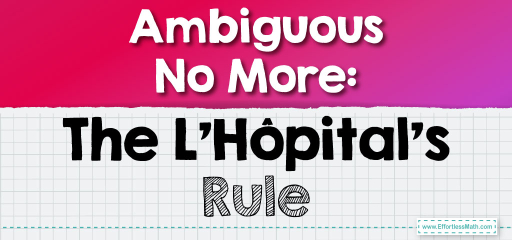Ambiguous No More: The L’Hôpital’s Rule
L'Hôpital's Rule, named after the French mathematician Guillaume de l'Hôpital, who first published it in \( 1696 \), is a method in calculus for evaluating limits of indeterminate forms like \( \frac{0}{0} \) or \( \frac{\infty}{\infty} \). This rule is highly reliable when the conditions for its use are met and simplifies complex limit problems, particularly in calculus.

To use L’Hôpital’s Rule effectively, certain conditions must be met:
- Indeterminate Form: The limit of the function as it approaches a certain point must be in an indeterminate form. L’Hôpital’s Rule is specifically designed to resolve these types of ambiguities.
- Differentiability: Both the numerator and the denominator of the function must be differentiable at the point of interest. In other words, you should be able to calculate the derivative of both the top and the bottom parts of the fraction around that point.
- Continuity of Derivatives: After taking the derivatives of the numerator and the denominator, the resulting functions must be continuous at the point of interest, or at least within an interval around it. This ensures that the limit of the derivatives exists.
- Non-zero Denominator: Post differentiation, the denominator should not be zero at the point of interest. If the denominator is zero, then the limit does not exist, making L’Hôpital’s Rule inapplicable.
- Convergence of the New Limit: Applying L’Hôpital’s Rule might need to be repeated multiple times until a determinate limit is found. It’s crucial that the process converges to a specific value or approaches a well-defined limit.
If these conditions are met, L’Hôpital’s Rule can be a powerful tool for finding limits that are otherwise difficult to compute.
It involves differentiating the numerator and denominator separately and then taking their limit.
requires examining the limit of the new fraction formed by these derivatives. If this new limit yields a finite value or another indeterminate, the rule can be applied again.
Let’s examine an example.
\( \text{Find } \lim_{x \to 0} \frac{\sin x}{x}. \)
Indeterminate Form:
\( \text{As } x \to 0, \ \frac{\sin x}{x} \to \frac{0}{0}. \)
We differentiate the numerator and the denominator separately:
Then apply L’Hôpital’s Rule:
\( \lim_{x \to 0} \frac{\sin x}{x} = \lim_{x \to 0} \frac{\frac{d}{dx}(\sin x)}{\frac{d}{dx}(x)} = \lim_{x \to 0} \frac{\cos x}{1} \)
Evaluate the limit of the simplified expression:
\( \lim_{x \to 0} \frac{\cos x}{1} = \frac{\cos 0}{1} = 1 \)
\( \lim_{x \to 0} \frac{\sin x}{x} = 1 \)
Therefore, the limit is \( 1 \)
Here is another problem:
\( \text{Find } \lim_{x \to 0} \frac{e^x – 1}{x}. \)
\( \text{As } x \to 0, \ \frac{e^x – 1}{x} \to \frac{0}{0}. \)
\( \lim_{x \to 0} \frac{e^x – 1}{x} = \lim_{x \to 0} \frac{\frac{d}{dx}(e^x – 1)}{\frac{d}{dx}(x)} = \lim_{x \to 0} \frac{e^x}{1} \)
\( \lim_{x \to 0} \frac{e^x}{1} = \frac{e^0}{1} = 1 \)
\( \lim_{x \to 0} \frac{e^x – 1}{x} = 1 \)
Therefore, the limit is \( 1 \)
Related to This Article
More math articles
- Number Properties Puzzle – Challenge 12
- How to Prepare for the ACT Math Test?
- How to Perform Similarity Transformations: Step-by-Step Guide
- CLEP College Algebra Formulas
- What are the Undefined Limits: Defining from Tables and Graphs
- How to Find Probability of an Event? (+FREE Worksheet!)
- 10 Most Common 8th Grade IAR Math Questions
- Full-Length ISEE Lower Level Math Practice Test
- Top 10 8th Grade PSSA Math Practice Questions
- 10 Most Common 4th Grade OST Math Questions


























What people say about "Ambiguous No More: The L’Hôpital’s Rule - Effortless Math: We Help Students Learn to LOVE Mathematics"?
No one replied yet.